Fieldwork Diary: Gina Hollaway (UCL Norton Fieldschool, 2023)
22 August 2023
In the next in a new series of fieldwork diaries, Gina Hollaway (1st year undergraduate student, UCL Institute of Archaeology) shares her experience of the UCL Norton Fieldschool in Suffolk.
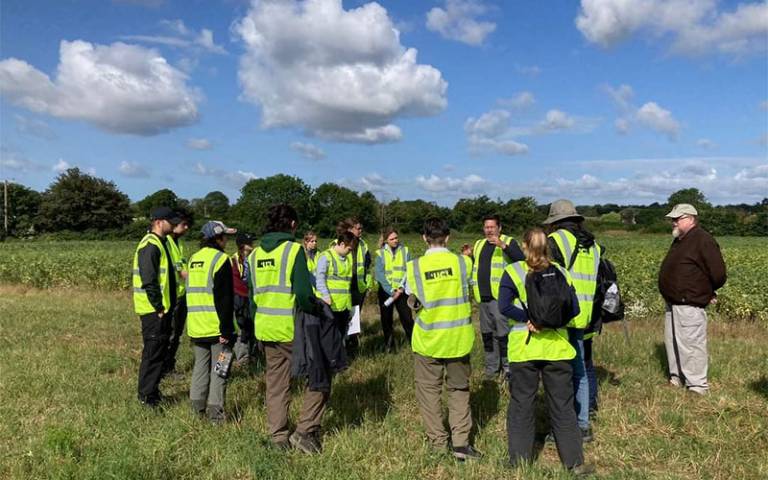
All students enrolled on an archaeology degree (BA, BSc, Archaeology and Anthropology and Classical Archaeology and Classical Civilisation) undertake a two week archaeological excavation at the end of their first year. This is a fieldschool in a real excavation to teach the students tangible archaeological skills and get first hand on-the-job training.
My year’s fieldschool was carried out in Norton in Suffolk. The site has been the subject of various investigations since 2005 that have recorded significant Roman remains including evidence of a villa-type building.
I was part of Group 2, arriving on Tuesday 11 July. I was dropped off at the site just after 4pm with my large haul of cargo. Knowing I was camping for 12 days, I chose to bring as much as I could. Air bed, camping chair, non-essential toiletries, camping trolley, etc. I do not regret taking lots of things because I had everything I needed, in fact if I drove myself, I would have brought even more! After setting up my tent, I killed time until other campers arrived and I helped them with their tents.
We started work the following day at 8:30am. We began with a tour of the site and got to see what Group 1 had been up to in the 12 days they had been working. I was placed on Trench 5 in the far north-eastern section of the excavation field and we got to work.
Students at Norton opening up Trench 5
Step 1: Clear back the grass and soil from the edges of the trench. | 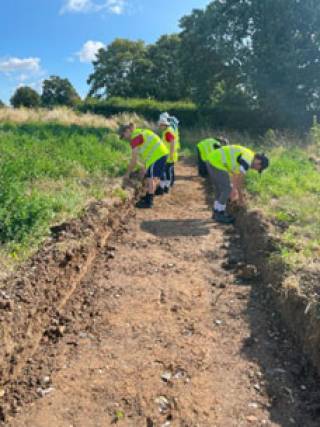 |
At 10:10am we stopped for a tea/coffee break followed by a short talk on osteoarchaeology and animals bones, focusing on the horse burial that Group 1 had discovered. At 12:15pm we stopped for our half-hour lunch.
Learning about photogrammetry, modelling
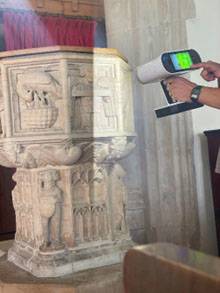 |
Our afternoon session was spent learning about archaeological photography, photogrammetry, drones, infrared, UV and 3D modelling. |
We had our afternoon break at 2:40pm, after which we returned to Trench 5 and continued cleaning and trowelling. At 4:30pm we finished work for the day and started our downtime.
From 6-9pm every evening we had access to the local village hall where we ate dinner and decompressed after the day’s work. Until this time we showered, changed, napped, talked, and updated our fieldwork notebooks for the day, doing whatever was needed to tide us over until dinnertime.
The following day we continued on Trench 5. I helped to uncover some of the features within the trench and then worked on the suspected pit at the north end, beginning with using a mattock to remove the top layers, finding the edge and uncovering any finds.
Trench 5 was part of the old excavation done in the early 2000s and we hoped to investigate some of the features that had shown up in the geophysical surveys. The new excavation revealed several postholes, a large pit, a smaller pit and the edge of the previous excavation trench.
After lunch we started to hand plan the trench. Others measured the distance between the feature and the central line and I added the measurements to the plan. It was a nice change from the heavy tools digging all day and gave me a well needed rest.
In the Trenches
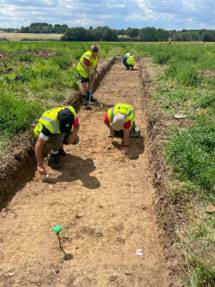 | 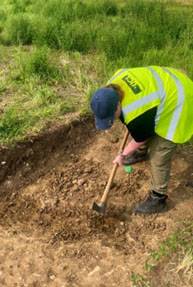 |
Group 1 had uncovered a horse burial in Trench 3 and we all ended the day with a talk around the trench, discussing what we had found and the possibility it was a roman horse buried at the entrance of the suspected villa. I volunteered to work on the horse the following day as it was Group 1’s last day on site and the horse was still not fully excavated. I had been looking forward to working on the horse since I arrived as I have an interest in osteoarchaeology and am fascinated with bones, both human and animal.
Horse burial
We started by cutting back the soil and finding the edge of the cut the horse was buried in. I was tasked with exposing the horse’s rear foot as the phalanges had not been revealed. Carefully with a trowel and some delicate tools, I removed the soil and yet could not find the finger bones at all. We suspect they could have been ploughed away. | 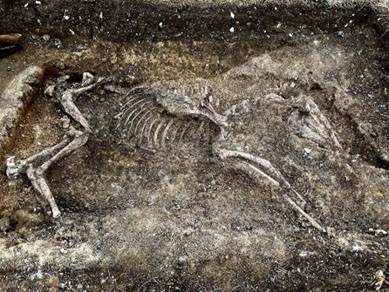 |
During the next few days we alternated between heavy digging with a mattock, careful excavation of the delicate bones, and various talks with different departments of archaeology. We had a talk on the various types of artefacts found, shown examples of various pottery from different eras, and cleaned and processed finds.
Ghost story
On Saturday night, after dinner and just as the sun began to set we were treated to a ghost story in the graveyard itself.
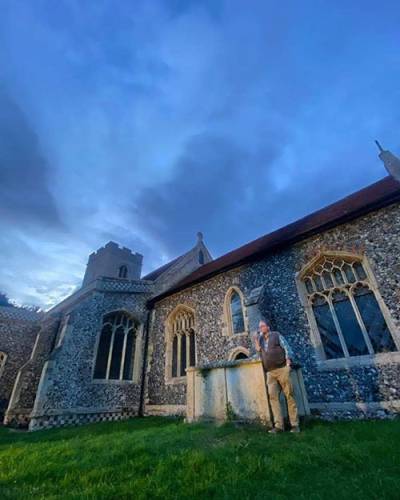
Sunday was our day off from digging and we spent the day in Bury St. Edmunds where we visited the Moyse's Hall Museum, learnt about Saint Edmund and the William Corder Red Barn Murder. We also explored the abbey and the ruins. It was good for our muscles to take a rest day but half of us were missing digging.
On-site conservation
I spent one more day working on the horse and the following day I had a lesson in simulated conservation where we had three simulated events we were to lift.
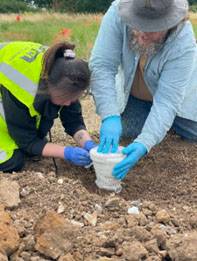 | One was lifting bones out of the ground using Plaster of Paris, the other was dry wrapping bandage around a broken pot and lastly was using a chemical wrap around an intact pot, the same bandage that is used for broken bones. This was an interesting way to see conservation in action. |
Those who needed a change from digging were able to work on post-ex, which included CBM (ceramic building material) processing and cleaning finds. I spent the rest of the week here processing finds as I found it to be the most enjoyable for me.
That was the best thing I found about this fieldwork, as well as learning on the job on an actual excavation, there is always something for everything. If heavy digging is not your thing, or drawing features, or hand planning, or context sheets, there is always finds processing. You do a little of everything and can find your niche.
Post-excavation finds processing
We began post excavation processing by cleaning finds. We do not wash metal as the specialist does that in the lab, and we dry wash bone first using dry toothbrushes and skewers to remove the majority of the dirt from the nooks and crannies first before washing in water.
CBM processing was next, by labelling, measuring and sorting the CBM into different types in order to process the bulk. We separated any good examples for the community open day at the end of the week and returned the others to be put back in the ground.
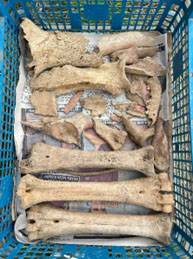 | 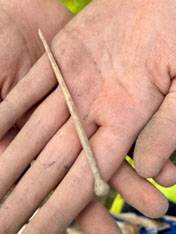 | 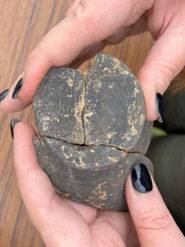 |
What I liked about finds processing was being able to see all the finds that have come out of the trenches. My personal favourites are the mass amount of bones (mainly cattle, but some pig and sheep, and of course the horse burial), a worked bone pin, and a roman pottery vessel made up of at least three, possibly four sherds that I was able to identify and hold back together.
Community open day
We ended the week by hosting a community open day for the local residents to come visit the dig site and learn about what we had found. I volunteered to man the show and tell table due to my previous experience with object handling desks. I explained the variety of CBM materials as well as a select few special finds we collected, such as coins, roman glass, animal bones, metal and pottery sherds.
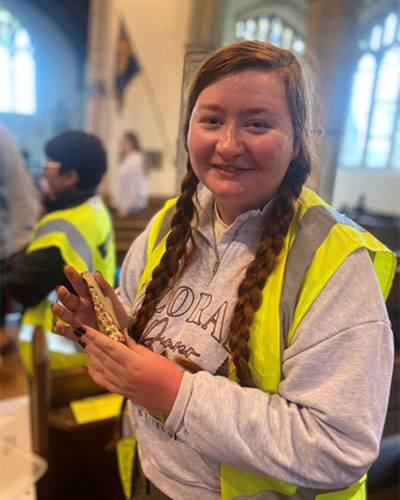
I thoroughly enjoyed the trip and was glad to see that there was something for everyone. Not every archaeologist works in the field and this fieldschool is a perfect way to give you a taste of some of the aspects of archaeology without drowning you in heavy fieldwork. All students undertaking an archaeology degree are required to undertake fieldwork during their degree, this fieldschool at the end of your first year is part of that and is the only compulsory excavation. The fieldwork can be undertaken as museum work or digital fieldwork if excavations are not your cup of tea.
I left this excavation with a new love for fieldwork, finds processing and experience with public archaeology, osteoarchaeology and commercial archaeology.
Links
 Close
Close

